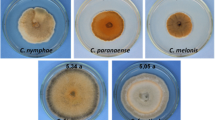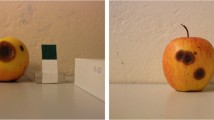Abstract
Colletotrichum acutatum is a cosmopolitan and damaging plant pathogen of temperate, subtropical, and tropical fruits and causes anthracnose on olive (Olea europaea L.). Three olive cultivars showing a variable response to infection by C. acutatum were selected to a preliminary study of pathogen development. Fruit samples, from susceptible and tolerant cultivars, were taken at 0, 24, 48, 72, and 192 h after inoculation for a microscopic and histological study of the infection and colonization process. The aim of this study was to compare the infection process: conidial germination, germ tube and appressorium formation, hyphal growth, and mesocarp colonization in susceptible and tolerant olive cultivars as a condition for further exploration of disease development, which is required to develop cultivars with improved resistance to anthracnose. The rate of mesocarp colonization differed between the susceptible and tolerant cultivars, and both intracellular hemibiotrophy and subcuticular intramural necrotrophy were observed. Hemibiotrophic infection predominated in the moderately tolerant cultivar.




Similar content being viewed by others
References
Curry KI, Abril M, Avant JB, Smith BJ. Strawberry anthracnose: histopathology of Colletotrichum acutatum and C. fragariae. Phytopathology. 2002;92:1055–63. doi:10.1094/PHYTO.2002.92.10.1055.
Bailey JA, O’Connell RJ, Pring RJ, Nash C. Infection strategies of Colletotrichum species. In: Bailey JA, Jeger MJ, editors. Colletotrichum: biology pathology and control. Wallingford: CAB International; 1992. p. 88–120.
Wharton PS, Diéguez-Uribeondo J. The biology of Colletotrichum acutatum. Anales del Jardín Botánico de Madrid. 2004;61(1):3–22. doi:10.3989/ajbm.2004.v61.i1.61.
Talhinhas P, Ferreira P, Neves-Martins J, Screenivasaprasad S, Oliveira H. Colletotrichum acutatum: principal agente causal da gafa da Oliveira em Portugal. III Simpósio Nacional de Olivicultura, Castelo-Branco, Portugal 2003.
Sreenivasaprasad S, Talhinhas P. Genotypic and phenotypic diversity in Colletotrichum acutatum, a cosmopolitan pathogen causing anthracnose on a wide range of hosts. Mol Plant Pathol. 2005;6(4):361–78. doi:10.1111/j.1364-3703.2005.00291.x.
Moldenhauer J, Moerschbacher BM, van der Westhuizen AJ. Histological investigation of stripe rust (Puccinia striiformis f. sp. tritici) development in resistant and susceptible wheat cultivars. Plant Pathol. 2006;55:469–74. doi:10.1111/j.1365-3059.2006.01385.x.
Skipp RA, Beever RE, Sharrock KR, Rikkerink EHA, Templeton MD. Histopathological, genetic, biochemical and molecular basis in Colletotrichum. In: Singh US, Kohmoto K, Singh RP, editors. Pathogens and host parasite specificity in plant disease. Oxford: Elsevier Science Ltd; 1995. p. 119–43.
Perfect SE, Hughes HB, O’Connell RJ, Green J. Colletotrichum: a model genus for studies on pathology and fungal–plant interactions. Fungal Genet Biol. 1999;27:186–98. doi:10.1006/fgbi.1999.1143.
O’Connell RJ, Perfect SE, Hughes HB, Carazaniga R, Bailey JA. Dissecting the cell biology of Colletotrichum infection processes. In: Prusky D, Freeman S, Dickman MB, editors. Colletotrichum: host specificity, pathology, and host–pathogen interaction. St. Paul: The American Phytopathological Society; 2000. p. 57–76.
Politis DJ, Wheeler H. Ultrastructural study of penetration of maize leaves by Colletotrichum graminicola. Physiol Plant Pathol. 1973;3:465–71. doi:10.1016/0048-4059(73)90056-8.
Ogle HJ, Gowanlock DH, Irwin JAG. Infection of Stylosanthes guianensis and S scabra by Colletotrichum gloeosporioides. Phytopathology. 1990;80:837–42. doi:10.1094/Phyto-80-837.
Mercer PC, Wood RKS, Greenwood AD. Ultrastructure of parasitism of Phaseolus vulgaris by Colletotrichum lindemuthimum. Physiol Plant Pathol. 1975;5:203–14. doi:10.1016/0048-4059(75)90087-9.
O’Connell RJ, Bailey JA, Richmond DV. Cytology and physiology of infection of Phaseolus vulgaris by Colletotrichum lindemuthianum. Physiol Mol Plant Pathol. 1985;27:75–98. doi:10.1016/0048-4059(85)90058-X.
Arroyo FT, Moreno J, García-Herdugo G, De los Santos B, Barrau C, Porras M, et al. Ultrastructure of the early stages of Colletotrichum acutatum infection of strawberry tissues. Can J Bot. 2005;83(5):491–500. doi:10.1139/b05-022.
Pring RJ, Nash C, Zakaria M, Bailey JA. Infection process and host range of Colletotrichum capsici. Physiol Mol Plant Pathol. 1995;46:137–52. doi:10.1006/pmpp.1995.1011.
Shen S, Goodwin P, Hsiang T. Hemibiotrophic infection and identity of the fungus Colletotrichum destructivum, causing anthracnose of tobacco. Mycol Res. 2001;105:1340–7. doi:10.1017/S0953756201005111.
Horowitz S, Freeman S, Sharon A. Use of green fluorescent protein-transgenic strains to study pathogenic and non-pathogenic lifestyles in Colletotrichum acutatum. Ecol Popul Biol. 2002;92(7):743–9.
Chongo G, Gossen BD, Bernier CC. Infection by Colletotrichum truncatum in resistant and susceptible lentil genotypes. Can J Plant Pathol. 2002;24:81–5.
Diéguez-Uribeondo J, Förster H, Soto-Estrada A, Adaskaveg JE. Subcuticular-intracellular hemibiotrophic and intracellular necrotrophic development of Colletotrichum acutatum on Almond. Phytopathology. 2005;95(7):751–8. doi:10.1094/PHYTO-95-0751.
Wharton PS, Schilder AC. Novel Infection strategies of Colletotrichum acutatum on ripe blueberry fruit. Plant Pathol. 2008;57:122–34.
Prieto P, Moore G, Shaw P. Fluorescence in situ hybridization on vibratome sections of plant tissues. Nat Protoc. 2007;2:1831–8. doi:10.1038/nprot.2007.265.
Kubo Y. Studies on mechanisms of appressorial penetration by Colletotrichum lagenarium. J Gen Plant Pathol. 2005;71:451–3. doi:10.1007/s10327-005-0229-9.
Diéguez-Uribeondo J, Förster H, Adaskaveg JE. Digital image analysis of internal light spots of appressoria of Colletotrichum acutatum. Phytopathology. 2003;93(8):923–30. doi:10.1094/PHYTO.2003.93.8.923.
O’Connell RJ, Uronu AB, Waksman Nash GC, Keon JPR, Bailey JA. Hemibiotrophic infection of Pisum sativum by Colletotrichum truncatum. Plant Pathol. 1993;42:774–83. doi:10.1111/j.1365-3059.1993.tb01564.x.
Smith JE, Korsten L, Aveling TAS. Infection process of Colletotrichum dematium on cowpea stems. Mycol Res. 1999;103(2):230–4. doi:10.1017/S0953756298006868.
Bailey JA, Nash C, O’Connell RJ, Skipp RA. Infection process and host specificity of a Colletrotrichum species causing anthracnose disease of cowpea, Vigna unguiculata. Mycol Res. 1990;94:810–4. doi:10.1016/S0953-7562(09)81382-8.
Zulfiqar M, Brlansky RH, Timmer LW. Infection of flower and vegetative tissues of citrus by Colletotrichum acutatum and C. gloeosporioides. Mycologia. 1996;88(1):121–8. doi:10.2307/3760791.
Leandro LFS, Gleason ML, Nutter FW, Wegulo SN, Dixon PM. Germination and sporulation of Colletotrichum acutatum on symptomless strawberry leaves. Phytopathology. 2001;9:659–64. doi:10.1094/PHYTO.2001.91.7.659.
Wharton PS, Schilder AMC. Infection and colonization of blueberry fruit by Colletotrichum acutatum. Phytopathology. 2003;93:S90.
Khan A, Hsiang T. The infection process of Colletotrichum graminicola and relative aggressiveness on four turfgrass species. Can J Microbiol. 2003;49:433–42. doi:10.1139/w03-059.
Latunde-Dada AO, Bailey JA, Lucas JA. Infection process of Colletotrichum destructivum O’Gara from Lucerne (Medicago sativa L.). Eur J Plant Pathol. 1997;103:35–41. doi:10.1023/A:1008698113368.
Latunde-Dada AO, O’Connell RJ, Nash C, Pring RJ, Lucas JA, Bailey JA. Infection process and identity of the hemibiotrophic anthracnose fungus (Colletotrichum destructivum) from cowpea (Vigna unguiculata). Mycol Res. 1996;100:1133–41. doi:10.1016/S0953-7562(96)80226-7.
Jeffries P, Dodd JC, Jeger MJ, Plumbery RA. The biology and control of Colletotrichum species on tropical fruit crops. Plant Pathol. 1990;39:343–66. doi:10.1111/j.1365-3059.1990.tb02512.x.
Broekaert WF, Terras FRG, Cammue BPA. Induced and performed antimicrobial proteins. In: Slusarenko A, Fraser RSS, van Loon LC, editors. Mechanisms of resistance to plant disease. Dordrecht: Kluwer Academic; 2000. p. 371–477.
Mansfield JW. Antimicrobial compounds and resistance: the role of phytoalexins and phytoanticipins. In: Slusarenko A, Fraser RSS, van Loon LC, editors. Mechanisms of resistance to plant disease. Dordrecht: Kluwer Academic; 2000. p. 325–70.
Moldenhauer J, Moerschbacher BM, van der Westhuizen AJ. Histological investigation of stripe rust (Puccinia striiformis f. sp. tritici) development in resistant and susceptible wheat cultivars. Plant Pathol. 2006;55:469–74. doi:10.1111/j.1365-3059.2006.01385.x.
Walker JC, Stahmann MA. Chemical nature of disease resistance in plants. Ann Rev Plant Physiol. 1955;6:351–64. doi:10.1146/annurev.pp.06.060155.002031.
Matos LC, Andrade PereiraJA, PB SeabraRM, Beatriz M, Oliveira PP. Evaluation of a numerical method to predict the polyphenols content in monovarietal olive oils. Food Chem. 2007;102(3):976–83. doi:10.1016/j.foodchem.2006.04.026.
Bentes JLS, Matsuoka K. Histologia da interacção Colletotrichum guaranicola e Paullinia cupana var. Sorbilis em clones resistente e suscetível. Fitolopatologa Brasileira. 2002;27:071–7.
Carvalho MT, Simões-Lopes P, Monteiro da Silva MJ, Pires S, Gonçalves MJ. The effect of Colletotrichum control on getting high quality olive oils. Proceedings of Second International Seminar: “Biotechnology and quality of olive tree products around the Mediterranean basin”, vol. II. 2006. p. 239–42.
Kerstiens G. Plant cuticles: an integrated functional approach, ed. 1997. Oxford: BIOS Scientific Publishers; 1996. p. 337. ISBN 1 85996 130 4. Cambridge University Press Copyright © Cambridge University Press.
Acknowledgments
This work was supported by Project ‘POCTI/AGR/57817/2004’ and a Ph.D. grant to Sónia Gomes, ‘SFRH/BD/25384/2005’ from the Fundação para a Ciência e Tecnologia, and by a ‘Proyecto de Excelencia- AGR649’ from the Junta de Andalucía.
Author information
Authors and Affiliations
Corresponding author
Electronic supplementary material
Below is the link to the electronic supplementary material.
Rights and permissions
About this article
Cite this article
Gomes, S., Prieto, P., Martins-Lopes, P. et al. Development of Colletotrichum acutatum on Tolerant and Susceptible Olea europaea L. cultivars: A Microscopic Analysis. Mycopathologia 168, 203–211 (2009). https://doi.org/10.1007/s11046-009-9211-y
Received:
Accepted:
Published:
Issue Date:
DOI: https://doi.org/10.1007/s11046-009-9211-y




